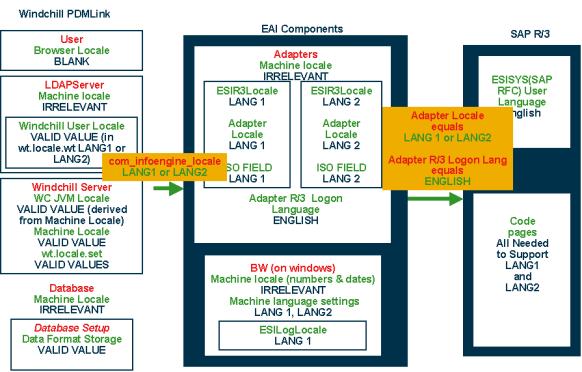Internationalization Considerations
This section describes the internationalization design considerations provided by Windchill ESI. You need to be aware of these when deploying Windchill ESI in an environment that traverses international boundaries.
Windchill ESI manages language data on a per transaction basis. Windchill ESI service detects an appropriate language fromWindchill PDMLink and communicates it to EAI software components via the JMS header property com_infoengine_locale that is sent with the Windchill ESI response message. Windchill EAI software components set this language for all subsequent sub-transaction requests toWindchill PDMLink or to the enterprise system. Windchill ESI Services get the language from the Change Administrator III's preferred language, if set, otherwise it uses the Windchill method server language.
Supported Languages and Locales
Windchill ESI supports eight languages and ten locales. These values map to nine unique SAP free text language key codes. All initialWindchill ESI messages are provided in theWindchill ESI supported languages listed in the following table. A systems integrator can localize these for additional locales and languages.
|
|
All PTC-developed code-level language is in U.S. English only.
|
|
Country
|
Locale Description
|
Windchill Language
|
Windchill Locale Value (Setting for com_ infoengine_ locale)
|
SAP Language
|
SAP Language Value
|
|---|---|---|---|---|---|
|
United States
|
English
|
English
|
en_US
|
English
|
EN
|
|
Great Britain
|
English
|
English
|
en_GB
|
English
|
EN
|
|
Japan
|
Japanese
|
Japanese
|
ja
|
Japanese
|
JA
|
|
Taiwan
|
Chinese
|
Chinese
|
zh_TW
|
Chinese Trad
|
ZF
|
|
China (PRC)
|
Traditional Chinese
|
Chinese
|
zh_CN
|
Chinese
|
ZH
|
|
Korea
|
Simplified Korean
|
Korean
|
ko
|
Korean
|
KO
|
|
Italy
|
Italian
|
Italian
|
it
|
Italian
|
IT
|
|
France
|
French
|
French
|
fr
|
French
|
FR
|
|
Germany
|
German
|
German
|
de
|
German
|
DE
|
|
Spain
|
Castilian Spanish
|
Spanish
|
es
|
Spanish
|
ES
|
|
Brazil
|
Brazilian Portuguese
|
Portuguese
|
pt-br
|
Portuguese
|
pt_BR
|
Setup and Control of Locale Variables
The locale information is controlled in bothWindchill PDMLink and SAP distribution target at the user level. TheWindchill ESI business logic does not translate language, date, or currency. In theWindchill ESI business logic, textual elements are not hard-coded; instead, they are stored outside the source code and retrieved dynamically.
The following describes how the locale information is controlled betweenWindchill PDMLink and EAI components and between EAI components and the SAP distribution target.
Locale Communication Between Windchill PDMLink and EAI Components
The locale of the data being sent fromWindchill PDMLink to EAI components is set byWindchill PDMLink in a variable called com_infoengine_locale. This value is set in the custom header field of the JMS message sent fromWindchill PDMLink to Windchill business logic. Only one locale value can be set for each JMS message sent from Windchill PDMLink.Windchill ESI uses the following logic (in the order listed) to determine how to set the value for the com_infoengine_locale variable:
1. Determine if there is a locale value for the browser locale and set the com_infoengine_locale value based on this value.
|
|
This functionality is not available in Windchill ESI; however, a placeholder has been created for customization purposes.
|
2. Determine if there is a locale value for the user in the LDAP server and set the com_infoengine_locale value based on this value
3. Determine theWindchill PDMLink server locale and set the com_infoengine_locale value to this.
Locale Communication Between EAI Components and SAP
Information on the locale and language of the data being sent from EAI software components to SAP is communicated through the following:
• The global variable ESISAPAdapter/Locale, which is set when configuring the TIBCO adapters for deployment. The default value is U.S. English (en_US). Refer to the section Global Variables for Adapter Instances for further details.
• The Adapter Locale value which is set in the TIBCO SAP adapter when deploying the adapter. Refer to "Configuring an Adapter Instance Deployment" in the Windchill Enterprise Systems Integration Installation and Configuration - SAP section for further details.
• The Adapter SAP Logon Language value which can be set only at design time. By default, it is set to English.
For materials and documents, there are ISO fields for languages in the SAP APIs that are also used to identify the language of the free text attributes being passed from the TIBCO adapters to the SAP distribution target.
BOM and CNs do not use these ISO fields. BOMs inherit free text descriptions from their BOMHeader part. CNs do not contain language keys for any free text fields so this setting does not affect them.
The following ISO values are used as defaults in these APIs. These fields can be configured by modifying the ESIDefaults.properties file. Refer to the ESIDefaults.properties description in the Windchill Enterprise Systems Integration Installation and Configuration - SAP section for details on this file. The values can be unique per system and locale. Refer to SAP API Structures in the Windchill Enterprise Systems Integration Installation and Configuration - SAP section for details on these ISO values.
|
API
|
API Field
|
API Field Description
|
|---|---|---|
|
Material
|
LANG_ISO
|
Material Description
|
|
Document
|
LANGUAGE_ISO
|
Document Description
|
The SAP language key for objects is set through different properties in theWindchill ESI business logic, depending on the object:
• Parts and Documents
A default value in ESIDefaults.properties file controls the language key of material description. The out-of-the-box value is EN.
• BOMs
BOM descriptions are derived from the material header. A default value in ESIDefaults.properties file controls the language key of material description. The out-of-the-box value is EN.
• CNs
No language keys are set for CNs. There is no associated language key for CN free text fields in SAP.
|
|
SAP logon language cannot be changed per adapter. Thus, every adapter instance connects to SAP using one language.
|
Summary of Language and Locale Variables Used
The following figure summarizes all the language and locale variables used in internationalizing Windchill ESI.
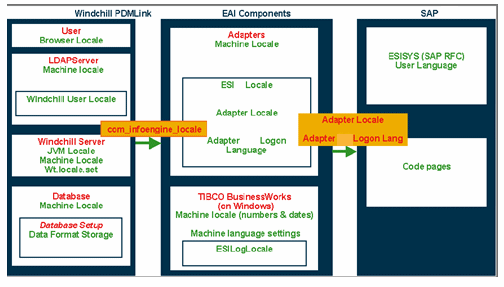
Internationalization: Business Scenarios
This section describes two valid internationalization business scenarios, each followed by suggested locale and languages variables.
Business Scenario One
The following figure illustrates a business scenario where users create, modify, and view data in one language in Windchill PDMLink and SAP.
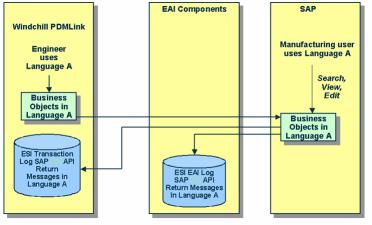
The following figure illustrates the suggested locales and languages to be used in the preceding business scenario.
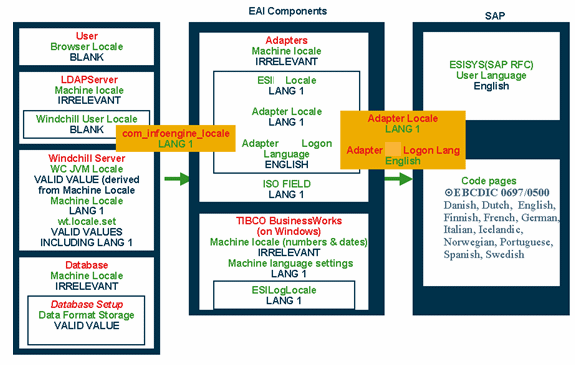
Scenario Two
The following figure illustrates a business scenario where some users create, modify, or view data in one language inWindchill PDMLink and SAP, while other users create, modify, or view data in another language. The data created, modified, or viewed by each set of users is not shared inWindchill PDMLink and SAP.
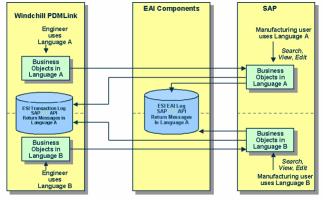
The following figure illustrates the suggested locales and languages to be used in the preceding business scenario.
